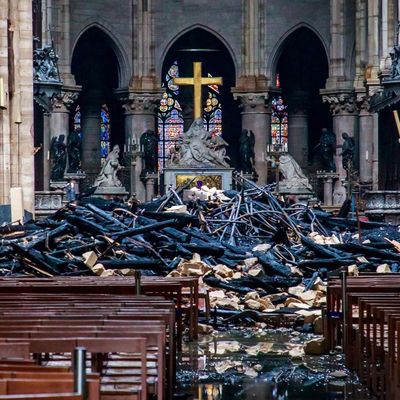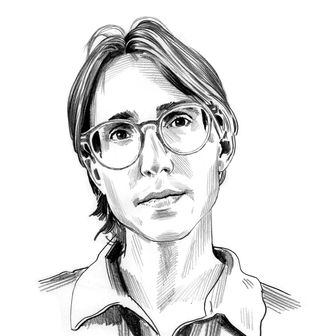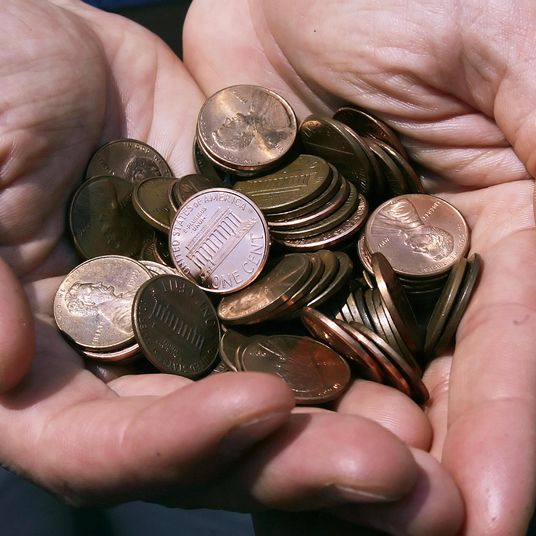
“We will rebuild Notre-Dame, because that is what the French expect,” President Emmanuel Macron said at a news conference on Tuesday, the day after an accidental fire destroyed the cathedral’s 19th-century spire and two-thirds of its medieval wooden roof. For observers throughout the world, the fire seemed to inspire conflicting feelings of mourning for the historic loss and hope for the astonishing number of features that remained intact, despite images of what appeared to be an all-consuming fire. As of Tuesday, both bell towers remain standing, and CNN reports that many of Notre-Dame’s most significant cultural and religious artifacts were saved, including the Crown of Thorns, the Tunic of Saint Louis, the Great Organ, the Rose Windows, and the Mays de Notre-Dame paintings.
With hundreds of millions of euros already pledged to the rebuilding effort, the day after the fire brings as many questions as the initial few hours of the blaze. To help make sense of the aftermath, Intelligencer spoke with Nicholas Paul, director of the Center for Medieval Studies at Fordham University, about the cathedral’s significance as a historical and symbolic object and where Paris goes from here.
When was the first time you saw Notre-Dame?
I remember visiting Paris as a child and my father and I raced each other up the stairs to one of the bell towers. I looked down, and outside was my mother waiting for us at the bottom. You really get the special sense of the place that the building occupies for people who study the Middle Ages. People who study medieval history were devastated emotionally by the initial reports coming in.
Could you explain the importance of the Notre-Dame — built in 1163 and finished in 1345 — to French history?
The story of the Notre-Dame is the story of the city of Paris, the beating heart of medieval civilization. The church began to go up when the kingdom of France really for the first time began to exert itself on the European stage. The kingdom of France originated in the 10th century just on the Île de la Cité — the island in the Seine on which the Notre-Dame sits — and gradually radiated outward from France. I don’t think that’s a story you can tell about any other country. As a result, the Île de la Cité is super-significant to French history, and its most enduring point is Notre-Dame. The cathedral is a place of great innovation, particularly with music, where the concept of polyphony — voices singing in different pitches at the same time — entered the Western tradition.
How did the cathedral change with the 19th-century restoration?
It was in a state of relative disrepair and neglect by the time of the French Revolution, after which the interior was radically altered. That renovation was an attempt to reemphasize the distant elements of the medieval world. One of the powerful things about the Middle Ages is that it combines something awe-inspiring with something very alien, something very different from us. So that’s when the gargoyles went up on the exterior. People see them now and say “Wow, that’s the Middle Ages,” but that’s actually the 19th-century version of the medieval world.
What do you think the greatest casualty of the fire was?
The roof itself is made from 12th-century timber. The very survival of that organic matter into the 21st-century spoke to the cathedral’s incredible process of engineering. It is a terrible loss. But the medieval community is taking a moment to recognize the engineering that allowed this building to stand up to such punishment. The vault was meant to keep debris out of the church, and that is what it did.
I thought a quote from Dr. Emily Guerry at the University of Kent provided some perspective for that loss: “In the Middle Ages … it was possible to find huge amounts of beautiful strong oak [but] the ability to find around 3,000 more big, strong trees in the next two decades is going to be tricky.”
Those oaks were harvested in the 12th century. In those days, the king had control over massive forested areas, royal forests there for the use and exploitation of the crown. You didn’t have independent companies logging forests, not to mention the sheer number of forested areas in Europe that are gone now.
Two police officers and a firefighter were injured in the blaze — thankfully, there were no fatalities. But could you speak to a larger sense of human loss?
The Notre-Dame was a product of generations of labor by thousands of craftspeople. The work was so complex, with so many levels of specialization, from the early machines that lifted the blocks into place to the artisans who installed tiny plates of glass by the tens of thousands of pieces. It’s difficult for us to comprehend what a collective effort it was to finish this building.
But you’re still hopeful about the restoration?
Yes, that goes back to the story of these buildings. They are always burning and falling and we are always fixing them. York Minster Cathedral suffered a terrible fire and it was rebuilt. Even St. John the Divine in New York City suffered a terrible fire, and it was rebuilt. It’s a different scale for the Notre-Dame, but the commitment seems to be there.
Macron has said “We will rebuild.” That raises a lot of “how” questions. Will they make it look like it did six centuries ago? Like it did after the 19th-century renovations? Like it did on Sunday?
I think there will be a strong argument to restore it to what it was like just prior to the fire, not to the original, which we know less about. I would imagine this will initiate conversation about Paris itself and what this building could reflect for those who live around it. The conversation will also include whether or not they should use period techniques. At St. John’s, I believe it was prohibitively expensive. But in York, it went quite well — you could see artisans working on the stones when you visited.
This interview has been edited and condensed for clarity.






























